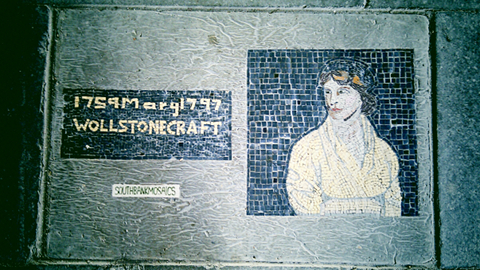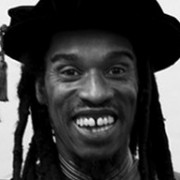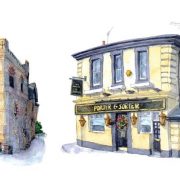In the second of a series on influential women from East London in celebration of Women’s History Month, ELL revisits the life and works of writer, philosopher and early feminist Mary Wollstonecraft.
The extraordinary life of Mary Wollstonecraft has left a curious legacy; her revolutionary writings are often overshadowed by the controversy surrounding her lifestyle, or by the achievements of her daughter, Frankenstein author Mary Shelley.
But the woman once dubbed a “hyena in petticoats” by man of letters Horace Walpole, is today remembered by many as the mother of British feminism, while her Vindication of the Rights of Woman remains an essential text in literature and gender studies classes across the country.
“She is alive and active [in her works],” wrote Virginia Woolf in 1929. “We hear her voice and trace her influence even now among the living.”
Mary Wollstonecraft was born in 1759 in Spitalfields, to John Edward and Elizabeth Dickson Wollstonecraft, and spent much of her childhood in Hoxton, Hackney. Mary’s early years were characterised by the downward spiral of her family’s social and financial situation, due to a reckless and violent father, and by her jealousy of her older brother, who was her mother’s favourite and received the education that she so ardently desired.
In 1784, aged 24, Mary and her sisters started a school in Newington Green, on the border between Hackney and Islington, and she was soon drawn into the community of Rational Dissenters who lived there.
At the house of moral philosopher Richard Price, 54 Newington Green, Mary became involved with the intellectual radicals who met there, including American Founding Fathers Benjamin Franklin and Thomas Jefferson, philosopher David Hume, political reformer John Horne Tooke, publisher Joseph Johnson and revolutionary Thomas Paine. She also met the man who would later become her husband: philosopher William Godwin.
The group proved fundamental in forming Mary’s own philosophies. “Through reading their works she came to theorise her personal sense of outrage at her childhood experience of family tyranny and gender discrimination,” says Janet Todd, President of Lucy Cavendish College, Cambridge, and author of Mary Wollstonecraft: A Revolutionary Life.
After the collapse of the school at Newington Green and a few short-lived stints as a lady’s companion and governess, Mary decided to pursue a career as an author – a radical choice for a time in which very few women were able to make a living from writing.
In 1790, she became famous almost overnight after the publication of the anti-monarchist A Vindication of the Rights of Men, a cutting response to Edmund Burke’s conservative Reflections on the Revolution in France.
Two years later, she went on to publish one of the earliest works of feminist philosophy and her most seminal work: A Vindication of the Rights of Woman. Written in response to Jean-Jacques Rousseau’s Emile, Wollstonecraft argued that women were not wholly inferior to men, but only appeared so because their lack of education left them in a state of “ignorance and slavish dependence”.
The work was well reviewed and was published in America and translated into French, and contemporary writers such as Anna Barbauld and Mary Robinson referred to it in their own writing.
“The 1790s were a period of liberating and revolutionary ideas and many women expressed theories rather like Mary’s,” Todd says. “What separated Mary from all the others was the boldness of her style and, in the case of the Vindications, the inflammatory nature of the titles, so close to the title of the most notorious book of the time, Tom Paine’s Rights of Man.”
Mary left for Paris that same year, arriving just a month before the execution of Louis XVI and, while there, fell in love with American adventurer and author Gilbert Imlay. When Britain declared war on France in 1793, Mary and her friends were suddenly in danger so Imlay registered her as his wife to protect her, although the pair were never actually married. The couple had a child together, but their relationship soon began to deteriorate and, after her return London in 1795, Mary twice attempted suicide.
In an attempt to try and regain Imlay’s affections, she travelled to Scandinavia with their child to carry out business negotiations on his behalf, and while there wrote Letters Written During a Short Residence in Sweden, Norway and Denmark. It was a work that proved particularly influential among the Romantic poets, including Wordsworth and Coleridge, for its consideration of the sublime and sensibility, and of the subjective experience of nature.
On her return to London, Mary again became involved with the intellectuals she had first met in Newington Green, and began a relationship with anarchist philosopher William Godwin. Despite Godwin’s writings in favour of the abolition of marriage in his treatise Political Justice, the couple married in 1797.
That year, Mary gave birth to her second daughter, also named Mary, who would later go on to marry Romantic poet Percy Shelley and to write Frankenstein. However, there was a complication after the birth and Mary contracted septicaemia and died just 10 days later, aged just 38.
After her death, Godwin wrote to his friend Thomas Holcroft: “I firmly believe there does not exist her equal in the world.” Godwin went on to publish his memoirs of Mary’s life the year after her death, in which he revealed her illegitimate children, love affairs and suicide attempts.
“Contemporary society was scandalised,” says Alex Allardyce, member of Mary on the Green campaign group and author of The Village That Changed the World: A History of Newington Green. “People began to associate her life with her writing and her reputation never really recovered until the revival of the feminist movement in the 1960’s.”
For the next hundred years, Mary’s writing was overshadowed by the notoriety of her life. Only with the suffrage movement was her work brought back into the spotlight, after Millicent Fawcett Garrett, president of the National Union of Women’s Suffrage Societies, wrote a new introduction to Rights of Woman in which she called Mary the foremother of the struggle for the vote.
Not until the second wave of feminism and the emergence of feminist criticism in academia in the 60s and 70s did Mary’s writing become as prominent as it had been at the time of its publication.
“While Vindication is the foundation of the British movement for women’s rights,” says Allardyce, “personally I feel that her greatest achievement is simply her life. She practically invented the modern woman and I really admire her ‘It can be done and I will do it’ attitude.”
“In the thirteen years between being radicalised at Newington Green until her death, she ran a pioneering school for girls, took on Edmund Burke and misogynist society and reported on the French Revolution and her travels to Norway and Sweden – alone with a baby.”
“You really couldn’t make her life up!”





